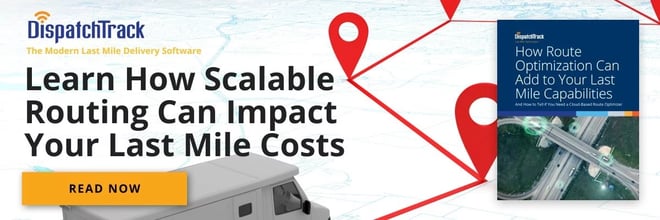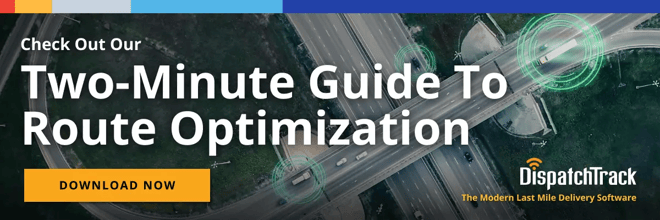Recent data shows that the public cloud service market will likely reach around $362 billion by 2022. Given that fact, it should come as no surprise that as cloud computing evolves, more and more enterprises are ditching their legacy route planning solutions and replacing them with SaaS solutions. This is the trend we’re seeing across a host of different solutions and industries, and last mile logistics is no exception.

But what exactly are the capabilities offered by SaaS-based route planning apps? How are they able to solve last mile delivery-related problems, and what makes them different from your average route planner?

In this article, we will discuss the many benefits of a SaaS-based solution, and we’ll give an account of why companies should make the shift.
The Benefits of a SaaS-Based Route Planning App
Scalability
It's virtually every company's goal to grow their businesses. Unfortunately, most legacy software does little to help companies expand their operations. Why? There are a number of reasons…
For one, legacy software tends to require companies to have their own dedicated hardware (i.e. servers) to run their routing software. Scaling up under these conditions requires you to either provision new hardware and find space to put it in (which can obviously be incredibly expensive and time consuming).
On the other hand, a SaaS-based routing solution empowers businesses to scale their operations with ease. Because there are no on-site servers, you can scale your usage up or down as needed without a Herculean effort. This means you can still take a cost effective approach to your software usage during seasonal shifts in usage.
Pay as You Go Pricing
Unlike traditional route optimization software, cloud-based solutions offer pay as you go pricing. Rather than a huge upfront investment in infrastructure, you can simply per month or per driver for as long as you’re gaining value from the solution.
Under the pay as you go model, the vendors are the ones hosting the routing optimization solution instead of the companies using the software. The vendors are the ones handling upgrades, maintenance, development, and data security. Companies simply have to use them and pay for their usage, which means in addition to saving money on infrastructure, you also avoid setup fees and costs associated with full time employees dedicated to maintaining the solution.
Accessibility
Legacy routing planners require the physical presence of the employee at a designated site. Though route planning isn’t necessarily something that has to be done in an office, on-premise solutions make it difficult or impossible to plan and manage the last mile remotely. This lack of accessibility is one of the major disadvantages of these legacy planners.
In contrast, a cloud-based route planning app essentially eliminates this problem. Users can access the planning solution anytime and anywhere using either their desktops, laptops, or even tablets. You only need a steady internet connection to access and use the tools; even when you’re away from the office, you can still find the shortest possible routes between the day’s stops, set the right sequence of stops, and respond to changes proactively.
Integration
Many legacy delivery route planner solutions don't allow for easy integration with other systems. This can create data silos and poor end-to-end visibility (since your different solutions aren’t effectively communicating with one another), which can in turn result in less efficient planning, management, and execution of last mile logistics.
On the other hand, the ideal cloud-based fleet routing software has integration capabilities that allow you to hook it up with your other enterprise systems. It might easily connect to your point of sale system, your telematics solution, and even your accounting software to create seamless workflows that can cover every touchpoint on the logistics chain.
This saves businesses money, since they don't have to purchase additional software to cover these gaps between solutions or to address persistent silos. It can also save a lot of time and effort on the part of back-office employees who would otherwise be stuck manually entering data into various solutions.
Faster Route Planning
Unlike legacy route optimization planning solutions, SaaS-based ones can use exactly as much computing power as they need to tackle the routing problem at hand. This means that whether you have 5 trucks or 5,000 that need to be routed, the right SaaS-based optimized route planning app can handle the process in a matter of minutes.

This is more than just a convenience. If you have to wait hours for your routes to finish optimizing, it’s much harder to make changes as new orders come in. You might receive a last minute order that you’d like to route for the next day—only to discover that the routing process won’t be done in time to schedule the order on one of the following day’s routes.
With a cloud-based solution, you can easily avoid that pitfall. That said, it’s worth noting that not all cloud-based route planning apps are created equal. Some scale up easily in a matter of seconds, while others have a tendency to slow down after a certain number of trucks.
Other Benefits
The above-mentioned benefits are the major ones. But businesses can still enjoy these additional benefits:.
- The ability to more easily evaluate and test the software before purchasing it
- Better UX/UI, which ensures that the solution is easy to learn and use
- Automatic back-up of data
- Virtual elimination of compatibility problems
All of this enables you to uphold the highest possible standards across your entire operation.
It should come as little surprise that SaaS-based route planning solutions can offer businesses so many benefits. When used correctly, these kinds of tools will allow you to cut down on unnecessary labor-related expenses without significantly increasing your IT spend.
This means you can focus on your expansion and let the cloud-based solution deal with the scaling issues. In this way, the right SaaS-based route planning app is a must-have tool for anyone eager to improve their productivity and grow their businesses.